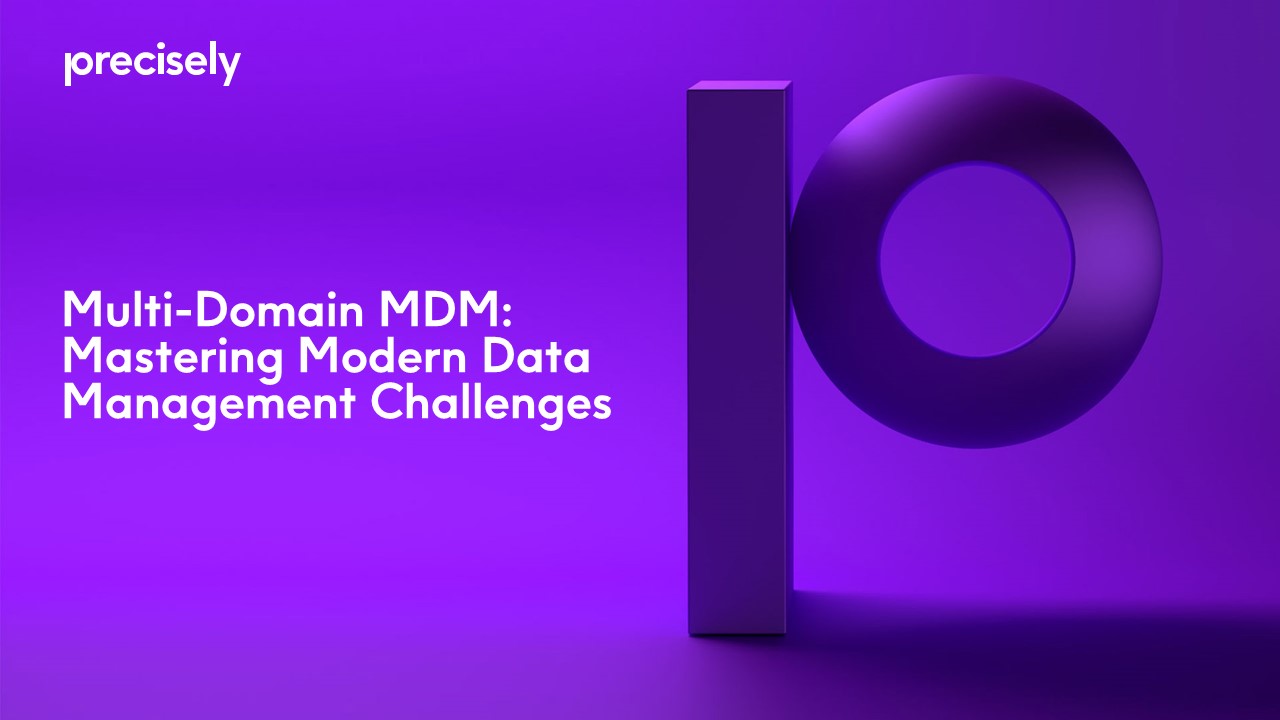eBook
Multi-Domain MDM: Mastering Modern Data Management Challenges
The time has come to liberate your data from single-domain silos. This eBook introduces the attributes and advantages of Multi-Domain Master Data Management (MDM), with guidance on how to get the most from your MDM journey.
Introduction
Organizations today are critically reliant on data. When harnessed, high-quality data can be the lifeblood of an organization, flowing through an enterprise to drive intelligence, innovation, and growth.
Yet all too often, companies can be overwhelmed by their data. Enterprise companies have grown to depend on multiple systems: ERP, warehouse, e-commerce, call center, CRM, accounting—the list goes on. Each system receives pieces of information by the system owner, and that data is managed, updated, and retired by the administrator of each system independently.
With the importance of trustworthy and timely data on the rise, Master Data Management (MDM) and data governance are ranking high on the radar of organizations, from the CEO and CMO to users along the lines of business. This eBook introduces the attributes and impact of Multi-Domain Master Data Management, with guidance on how to get the most from your MDM journey.
Large enterprises today are managing an average of over 37 active and unique data sources.1

Why Siloed Domains Don’t Stack Up
Initially, MDM solutions focused on a single domain, namely the customer or a product, in a narrow approach that didn’t account for the fact that data flows in from a variety of sources that are critically related. Without establishing appropriate connections and relationships among domains, organizations actually create deeper silos of fragmented data.
Enter Multi-Domain MDM
As a critical part of a wider enterprise information management (EIM) strategy, Multi-Domain MDM enables an integrated and modern approach to mastering data based on a single, seamless technology platform—with unified governance, modeling, mapping, and management of all data domains.
Single Domain vs. Multi-Domain MDM
- Cost: Operating multiple siloed domains is costlier than one centralized multi-domain hub that meets all requirements.
- Resources: Single-domain solutions result in wasted implementation resources, as well as redundant training and maintenance.
- Governance: Retaining single-domain silos causes organizations to face constant barriers in data governance practices.
- Agility: Single-domain solutions lead to slower responses and time-to-market because the business lacks common references and business rules across domains.
By creating a clear and holistic view of enterprise-wide information, Multi-Domain MDM helps eliminate the guesswork and uncertainty that results from data gaps and inconsistencies.
With Multi-Domain MDM, businesses can:
- Create a “golden record” for data entities by integrating databases and systems such as ERP, CRM, WMS, and OMS, and even hard-to-integrate legacy systems that are difficult to access and even more difficult to decommission.
- Enhance data quality with the ability to extract, load, publish, and syndicate accurate and consistent content to internal and external recipients.
- Improve the efficiencies and quality of decisions for enterprise processes that rely on trusted and accurate information.
- Integrate views of a variety of domains including customers, products, suppliers, employees, assets, references, locations, and other core components of the enterprise.
- Reduce costs, streamline information management, and deliver accurate, complete, timely, and consistent views of information that are critical to achieving business objectives and strategies.
“The shift in the MDM market toward a more holistic set of solution capabilities, and the resulting set of new evaluation criteria and weightings, has produced a significantly different view of the market”
Gartner Magic Quadrant2
Enabling Cross-Domain Intelligence Through Multi-Domain MDM
Enterprise companies have grown to depend on multiple systems, each with its own internal and external sources of data. With Multi-Domain MDM, single-data domains like the customer, the product, the supplier, and others are merged, cleansed, and enriched.
As a result, more intelligence can be automated with single domain data when it is combined with other data domains.
Multi-Domain MDM offers a 360-degree view of data across domains. Data comes in from a variety of sources, is filtered into the MDM system, and then linked to other data or domains. This cross-domain view enables an unparalleled level of intelligence.
Let’s look at an example of what can be accomplished if an organization centralizes its Customer Master Data through MDM. If a buyer updates his LinkedIn profile with a new job, for example, this may initiate a series of events.
The system may tell CRM that the salesperson has to develop a new relationship, notify accounting that invoices should go to someone new, and update e-commerce that a login must be deactivated but to continue certain auto responses and reporting.
When information is updated only in siloed systems, enterprises lose the ultimate power of knowledge that is gleaned from touchpoints that are communicating. Yet if organizations centralize data in each system to MDM, intelligent actions and decisions can be executed based on a single source of truth.
69%
of companies with a multi-domain approach to MDM saw an improvement in decision accuracy.3
Aberdeen
Connecting the Domain Dots
Multi-Domain MDM enables organizations to manage multiple domains of data and easily link objects from those domains to create dynamic virtual relationships. All administrative, stewardship, and governance functions across the multiple domains (and implementation styles) can be achieved from a single user interface.
Product Master
Managing product data for a vast number of products, with possibly thousands or even millions of attributes, is a daunting task. From retailers to distributors and manufacturers—all organizations are challenged with remaining competitive and keeping product information up-to-date, consistent, and compelling. This is particularly true if the information is found in disparate spreadsheets and systems across the organization. Multi-Domain MDM with a Product Master Domain helps companies:
- Aggregate and consolidate product information, delivering accurate and consistent information from a single source of data.
- Deliver a differentiated omnichannel customer experience by sharing information seamlessly from back-end to frontend, with trading partners, and syndicating information across channels.
- Deliver a new level of business performance with
operational efficiency and reduced time-to-market. - Easily meet the ever-evolving list of industry regulations
and standards.
“Multi-domain and multi-vector MDM enable digital business to advance from ‘collecting’ data for a single data domain to ‘connecting’ several data domains.”4
Gartner
Customer Master
Understanding your customer helps your organization deliver relevant, personalized content through the right channels, at the right time in your customer’s purchasing lifecycle. As a high-volume merge domain, the Customer Master manages a constant influx of intelligence around customers, prospects, suspects, and influencers.
The MDM system must identify activity around a customer and update the profile accordingly. For example, for consumers, the system must ingest marketing data about their household, who else lives there, how much each person makes, and their level of education. For business customers, the system must map their role and demographic information, as well as take in financial and geographic information on the employer’s business and operational locations. The intelligence to be built around the customer from external sources makes a highly compelling demonstration of Multi-Domain MDM.
Vendor Master
An MDM platform can manage vendor data alongside customer and product data. A Vendor/Supplier Domain enables creating and managing the supplier master record. Organizations can maintain and optimize relationships between customer, vendor, and products through a single platform by standardizing vendor information and processes across brands and geographies.
Location Domain
Adding a Location Domain enables distributors, manufacturers and other organizations to manage information related to retail store locations, manufacturing plants, warehouses, regions, and more. For example, if a manufacturer sells to a large retail chain, but certain products are not sold in certain regions, they can track and link this product and location information to ensure the right inventory is sent to the correct stores.
Asset Domain
An Asset Domain, including Digital Asset Management (DAM), makes storing, categorizing, and managing images, documents, templates, audio and video files, and related metadata easier than ever. Assets are centrally stored and managed through the MDM system, with capabilities to link relationships and associating assets to information for consistency and easy tracking, searching, and reporting.
An Asset Domain can also be utilized to manage information around physical assets, like construction equipment or spare parts, for example. Tracking the specifics around what equipment is available in each store helps ensure that only compatible products are sent to each location.
Reference Domain
A Reference Domain allows reference metadata to be obtained from an internal or third-party source, and then sent into the MDM system to be repurposed or utilized across domains or use cases. Examples include color standards, units of measure, or currency exchange rates for pricing transformations in difference countries.
Other Domains Include:
- Partner
- Trade Area Intelligence Data
- Order Data
- Legal Claims
- Marketing Programs
- Menu Data
- Schedule Data
- Artist
The Data Governance Difference
One of the most significant benefits of Multi-Domain MDM lies in the area of data governance. Moving data out of silos and into a central repository puts data governance in the spotlight for increased transparency.
Through a multi-domain approach, governance councils are granted unparalleled visibility to data and information throughout the entire organization. Furthermore, the transparency Multi-Domain MDM provides pulls individual business users into the process as well. Because users are empowered by and interacting with applications on a regular basis, they are increasingly involved in data stewardship.6
This level of governance puts companies in a position to transform data into insights that drive better decision making and leads to long-term, sustainable transformation.
“Multi-domain and multi-vector MDM enable digital business to advance from ‘collecting’ data for a single data domain to ‘connecting’ several data domains.”
Gartner4
Data Without Rules
Finally, it’s important to note that the benefits of MDM aren’t the results of simply managing data or information. MDM capabilities are inert unless integrated with business applications that leverage the data.
Forrester Research drives home the point, noting:
“High-quality and trustworthy data sitting in some repository somewhere does not in fact increase revenue, reduce risk, improve operational efficiencies, or strategically differentiate any organization from its competitors. It’s only when this trusted data can be delivered and consumed within the most critical business processes and decisions that run your business that these business outcomes can become reality.”6
Multi-Domain MDM includes several features that bring the value of data to life, including:
Synchronization
Synchronizing master data efficiently and effectively to multiple systems, channels, and touchpoints is one of the strengths of a Multi-Domain MDM platform. This encompasses collecting, ingesting, federating (synchronization with internal systems) and syndicating (synchronization outside the organization). The MDM system can manage bi-directional data synchronization and acts as a “command and control” center that can power and govern data across a variety of applications.
Workflow
As Gartner notes, “Organizations that see their MDM systems as a foundation for service-oriented architecture (SOA) will need a rich library of business services surrounding the data model.”7 Multi-Domain MDM is uniquely designed to integrate with automated workflow and business process rules that help provide the “kinetic energy” that underlies the applications leveraging master data and information. With the recording of workflow steps and reporting capabilities, companies can benchmark their performance over time on key business processes related to MDM, such as new product introductions, assortment planning, catalog layout, vendor data onboarding, data governance and data cleansing.
Integrated Business Applications
The value of MDM is further derived from delivering the master data to integrated business applications that leverage the data, such as multichannel publishing and vendor/supplier portals.
Another application example is EnterWorks’ Storeytelling concept. With this approach, retailers can recapture the essence of merchandising and product stories to create visual customer experiences. Through Storeytelling, EnterWorks will link virtual reality to assortment planning and planogramming, which helps merchandisers effectively place and promote their products in the store environment. Another side of the Storeytelling concept involves a 3D store environment that can be published to the web, and then browsed by shoppers, with options for purchasing. Through a single repository of content, thanks to EnterWorks, content fuels the product information needs of merchandising, e-commerce, and store applications that need it. This can be accomplished by infusing virtual and, eventually, augmented reality into these existing systems.
EnterWorks
EnterWorks has deep domain and business experience with leading companies across various manufacturing, distribution, retail, and hospitality industries. Our customers leverage EnterWorks Multi-Domain MDM to drive best-in-class customer experiences, optimize internal processes, drive consistent and accurate data across the value chain, and integrate trading partners to extend their brand.
Single view of content
Differentiated experiences
Complexity remastered
Modeling Data
- Heritage in complex data environments
- Handle both structured and non-structured data
- Flexibility; no coding to change
- Solution adapts to business, not vice versa
Enriching Data
- Role based UI: flexible and easy to customize without coding
- Data governance: attribute-level security, flexible promotion/validation rules, flexible workflow, dashboard views
- All data treated as objects
Acquiring Data
- Strong data Integration technology and experience
- Collaborative supplier portals
- Workflow driven data input processes; internal and external people and systems
Sharing Data
- Multiple methods for exporting data – Push and/or Pull
- Automated syndication in target format
- 2-way dealer portals
- Multi-Channel publishing for print/online
EnterWorks MDM Platform
The EnterWorks MDM platform provides a framework of technologies and processes with a central repository of reliable, up-to-date master data consolidated across all enterprise applications. The platform efficiently combines critical elements of complex data domains, provides tools to improve data quality, and prescribes data governance mechanisms for consistent use of that data.
EnterWorks was developed from inception to master multiple unlimited domains and the relationships between them. Domains can be easily tailored to meet your business model and preferences, rather than your company being forced to fit a preexisting notion of the data structure.
With EnterWorks, companies easily:
- Tailor content and master data to industries, geographies, and position in the value chain
- Address physical or digital solutions and the underlying business processes
- Support the role of individual users to drive efficiency and effectiveness
- Enable differentiated, on-brand customer experiences
- Enrich content and data for user-touchpoint personalization
- Converge data to dynamically link supply and demand chains
- Master and manage all domains
- Homogenous platforms with the latest, proven technologies
- Gain insights and drive performance with real-time analytics and dashboard
- Benefit from on-demand cloud deployment
Key Benefits
- Improve customer experience
- Meet global language and format requirements
- Increase performance and profitability
- Enable faster time-to-market
- Ensure channel specific information
- Reduce supply chain complexity
- Enhance operational efficiency
- Increase IT agility
- Mitigate risk
EnterWorks Competitive Differentiators
EnterWorks stands out as the best solution for companies based on the following functional differentiators:
Flexible Data Model
- Highly flexible and configurable by business users
- Solution adapts to a company’s business, not vice versa
- Ability to model the content entities required for this project, as well as for future company business needs
Integrated DAM
EnterWorks provides an enterprise Digital Asset Management (DAM) domain that allows businesses to easily store, categorize, and manage unstructured content such as images, documents, templates, audio and video files, as well as other documents related to products and product catalogs. Unstructured data, including documents, that are stored in the DAM can be manually or programmatically linked to a product, item, brand, etc. The linked relationship between a product and the unstructured data is bi-directional, meaning that a user can easily determine all products that have been linked to a document which is important in use cases when unstructured data expires.
Enterprise Workflow
- 100% developed and owned IP, fully integrated with PIM functions
- Drag-and-drop design that is more flexible than other workflow solutions
- Out-of-the-box workflows
Requires No Coding
- Business users can configure and manage the solution without IT involvement
- 100% web-based
- Designed for users and administrators alike
Highly Scalable
EnterWorks has been architected to support a wide variety of scenarios, whether it be a large number of content entities, a large number of concurrent users, or a large number of concurrent imports and exports.
Deployment Options
The product fully supports cloud, hybrid, and on-premises deployments.
Key Features:
- Automated Workflow/BPM Engine
- Dynamic Data Modeling
- Full Fledged DAM as a Domain
- Speed of Implementation, with systems live in as little as 90 days
- Lowest TCO
- Multi-Channel Syndication
- Loading, integration and synchronization
- Information quality/semantics
- Performance, scalability, availability and security
- Hierarchy management
- Information stewardship support
- Information governance support
- Integrated complimentary capabilities including PIM, Multi-Channel Publishing, Portals and more
- Content Lifecycle Management
- Purpose-Built Apps
- Multiple Deployment and License Options
Synchronization
- Synchronization can be initiated manually, scheduled, and/or triggered by an event such as a change to the product record.
- Through a new microservices framework (Application Programmable Interface, Enterprise Service Buffs, etc.), subscribers can seamlessly query data to see what changes have been made. Changes are automatically sent to the consuming application without any manual exports.
- Out-of-the-box integration methods are supported, such as GDSN.
Data Security
Data security can be implemented at multiple levels. Access can be configured as read-only, read / write, or the object or attribute can be hidden from the user view altogether as well. Security can be set on the user role, user, object or entity, and even down to the attribute level.
Content in Context
EnterWorks’ Multi-Domain MDM capability supports the requirements for both online and offline products, serving up information to a variety of touchpoints from marketplaces to mobile, POS to Print, with workflow-driven and automated processes. This enables the “content in context” approach, where companies require combinatorial outputs to deliver personalized and targeted offers across various touchpoints with consistency. The strategy encompasses business-to-business (B2B), business-to-consumer (B2C), and business-to-business-to-consumer (B2B2C) use cases.
Leading Customer Satisfaction & Support
EnterWorks has 100 percent customer referenceability based on many years of delivering high-quality service and solutions. This extraordinary level of customer response has led analyst firms to report the highest marks of customer satisfaction for EnterWorks.
Fastest Time to Value & Lowest TCO
EnterWorks offers the fastest time to value and lowest total cost of ownership in the industry (as validated through the research of analyst firms, consultants and Solution Integrators). For our customers, this will mean a widelyadopted, best-in-class solution that is the most efficient in its implementation and maintenance. While some vendors take up to a year or more to implement, EnterWorks can go live in as little as 90 days.
Conclusion
A Multi-Domain MDM implementation can drive consistency and accuracy in data across your domains; reduce costs in implementation and maintenance; add a new level of data quality, governance, and stewardship across your enterprise. Ultimately, the goal of Multi-Domain MDM is to connect the dots between domains to enable an unparalleled level of intelligence around the relationships between products, customers, suppliers, and more.
Therefore, as you embark on your MDM journey, carefully consider how you will implement the technology, the best processes, and the practices that will best maintain, grow, and transform your business.
The right MDM partner can help you say so long to silos and hello to a successful multi-domain implementation.
If you’re considering an MDM solution, we hope you’ll contact us. The EnterWorks team would love to learn more about your company, discover your data challenges, and discuss how our solutions can help address your needs and opportunities for growth.
1. Toomey, Matt. Multi-domain MDM Tackles Modern Data Management Challenges, Aberdeen Essentials, January 27, 2017.
2. O’Kane, Bill, and Terilyn Palanca, Michael Patrick Moran. Gartner Magic Quadrant for Master Data Management Solutions, Gartner Research, January 19, 2017.
3. Lock, Michael D. MDM Without Limits: Connecting Data, Crafting Insight, Mastering Results, Aberdeen Group, January 2017.
4. James, Simon Walker, and Michael Patrick Moran. Three Top Trends in Master Data Management Solutions Through 2017, Gartner Research, February 20, 2017.
5. MDM Without Limits, Aberdeen.
6. Data Governance Remains Immature: Increase Focus On Business Process To Build Momentum. Forrester Blogs, July 1, 2010, https://go.forrester.com/blogs/10-07-01-data_governance_remains_immature_increase_focus_ on_business_process_to_build_momentum/.
7. Radcliffe, John. The Seven Building Blocks of MDM: A Framework for Success. Gartner Research, October 11, 2007









